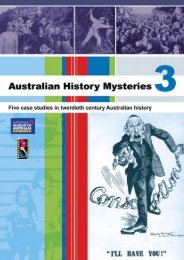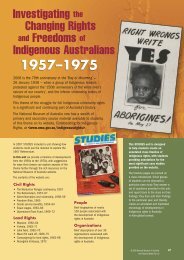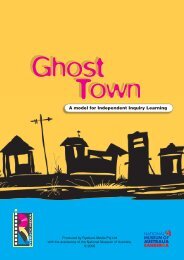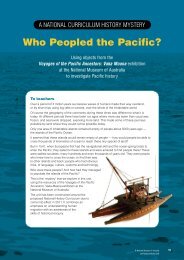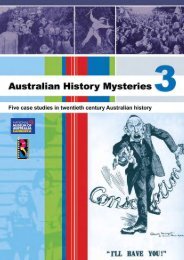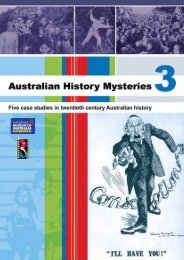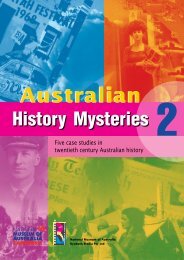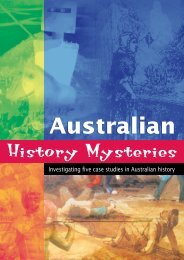Download Teacher Guide & Print Resources - Australian History ...
Download Teacher Guide & Print Resources - Australian History ...
Download Teacher Guide & Print Resources - Australian History ...
Create successful ePaper yourself
Turn your PDF publications into a flip-book with our unique Google optimized e-Paper software.
Activity page 2<br />
You be the historian<br />
1 Look at sources A – C, and using ONLY these images as evidence, decide if the following statements are<br />
Probably true (T), Probably false (F), or Cannot be known from this evidence (?). In each case decide what<br />
the best evidence is to support your conclusion, and why. One example has been done to help you.<br />
Statement T F ? Best supporting evidence<br />
The crossing was in 1813<br />
A and B both say this<br />
The crossing was made by three men<br />
Blaxland was the leader<br />
The crossing was difficult<br />
They crossed the mountains to find new land<br />
They were the first people to cross the Blue Mountains<br />
This resulted in the spread of settlement in New South Wales<br />
The explorers were proud of their achievement<br />
This is an important moment in <strong>Australian</strong> history<br />
The explorers were heroes<br />
2 You have realised that the three sources agree on some things, but disagree on others. Why do you think<br />
documents can disagree?<br />
3 Why do you think these documents can only partially answer some of the questions in the table?<br />
4 Which of these documents are you most likely to accept as the most accurate? Why?<br />
5 Some additional questions that you would like to ask about the sources are:<br />
6 Some additional questions that you would like to ask about the event are:<br />
Congratulations! You have just become a historian, because you have:<br />
> looked at a significant event in the past;<br />
> identified some evidence about it;<br />
> critically analysed or interrogated the evidence;<br />
> compared sources;<br />
> made judgements;<br />
> come to conclusions;<br />
> justified those conclusions;<br />
> identified strengths and weaknesses in your knowledge and understanding;<br />
> empathised with the people involved in the event; and<br />
> realised that you need to explore further to reach a final conclusion.<br />
And that’s what this unit does — it helps you to explore the crossing of the Blue Mountains in more detail, and<br />
to improve your knowledge, understanding and empathetic awareness of the event.<br />
In doing so, you will be introduced to some myths and mysteries associated with the event. By considering the<br />
evidence you will be able to ‘bust’ or confirm these myths, and solve some mysteries.<br />
Historical inquiry always involves some key questions:<br />
> What?<br />
> When?<br />
> How?<br />
> Who?<br />
> Why?<br />
> Impacts or consequences?<br />
> Significance?<br />
> Whose perspective is being presented?<br />
Your task at the end will be to answer these questions for the 1813 crossing of the Blue Mountains.<br />
Use the table on the next page to summarise information and ideas as you work through the evidence.<br />
Myths and Mysteries of the Crossing of the Blue Mountains<br />
9




